Korean Women’s Relief Society
대한부인구제회
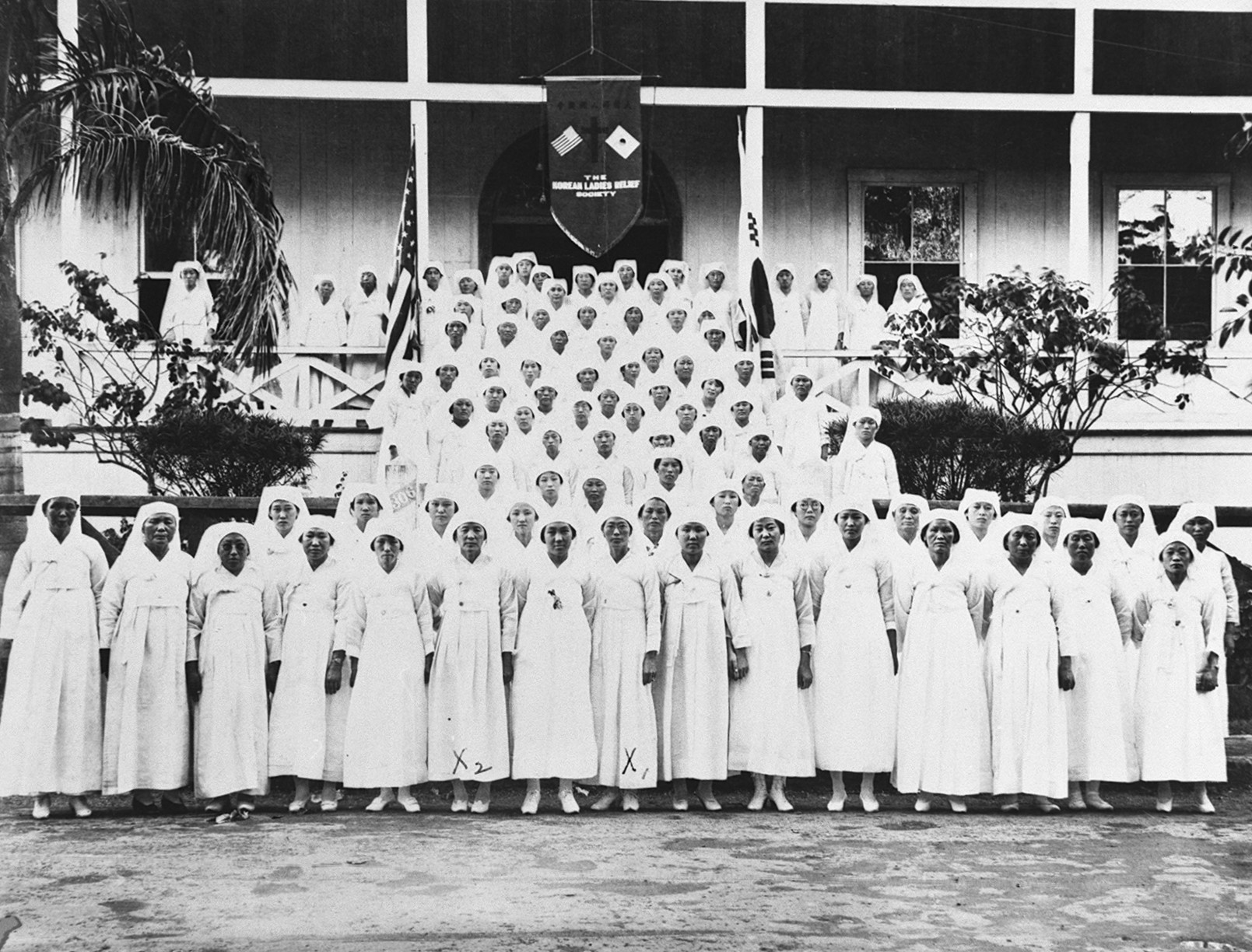
The Korean Women’s Relief Society 대한부인구제회 was organized in 1919. Upon learning about the news of the March First Independence Movement in Korea, 41 representatives of various branches of the Korean Women’s Association (KWA), which was established in 1913, met on March 15. They decided to regroup KWA into the Korean Red Cross. Although they wanted to use the name “Korean Red Cross”, the Hawaii Chapter of the Red Cross told them that “Korean” could not be used because Korea was not an independent country. Thus, the name “Korean Women’s Relief Society (KWRS)” was settled upon. “Ladies” and “Women’s” were interchangeably used.
The objectives of the organization were:
- To help those who were wounded during the March First Independence Movement and those who were wounded in the continuing fight for independence, and
- To maintain true Korean women’s character, chastity and etiquette.
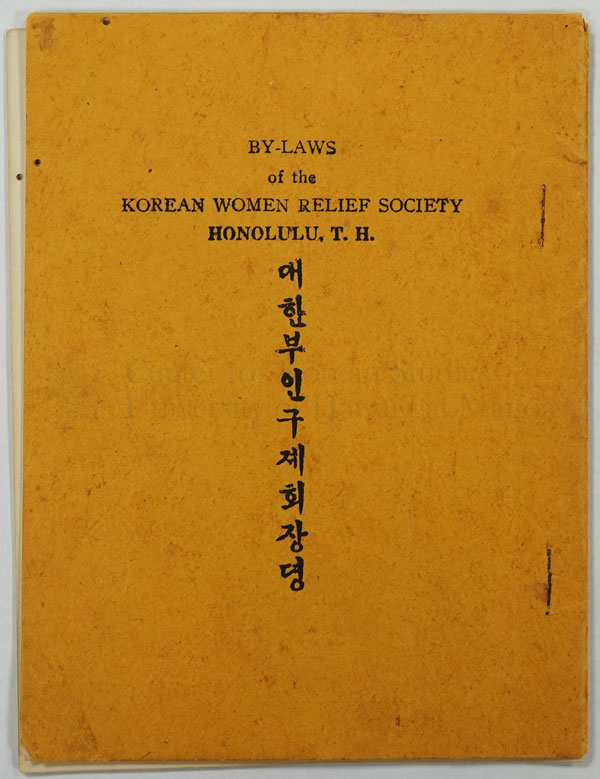
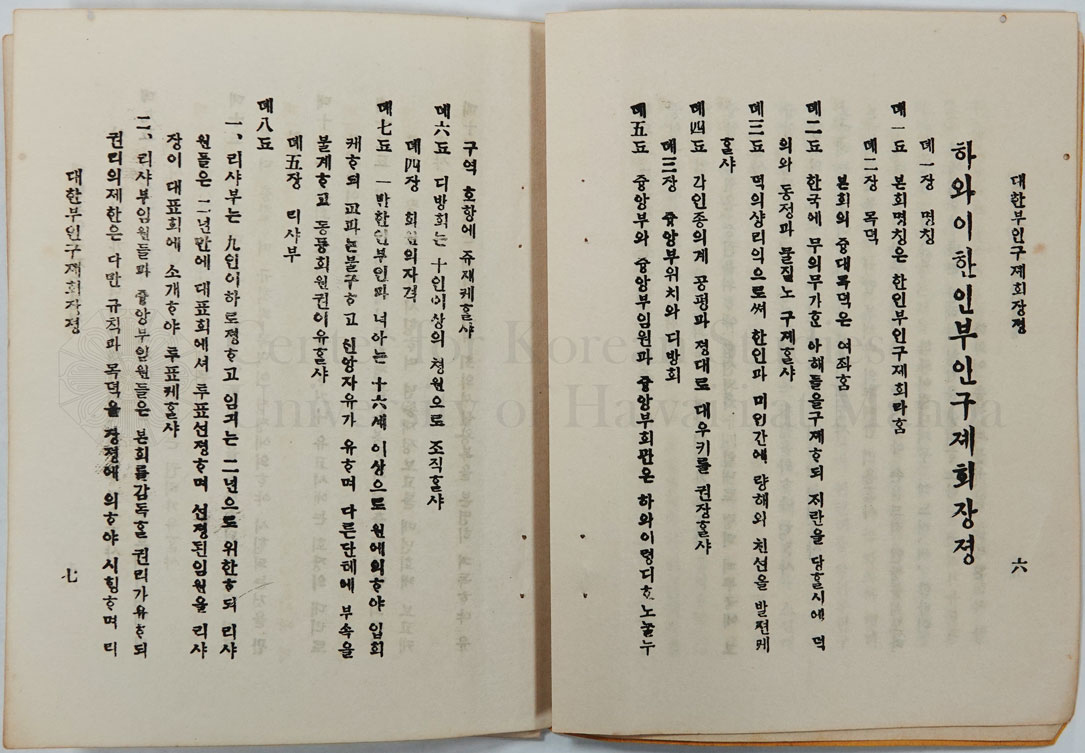
For special occasions, KWRS members wore white traditional Korean costumes (hanbok) and wore white headgear with a red cross. The red cross was KWRS’s logo. KWRS's flag and membership certificate bore a red cross.
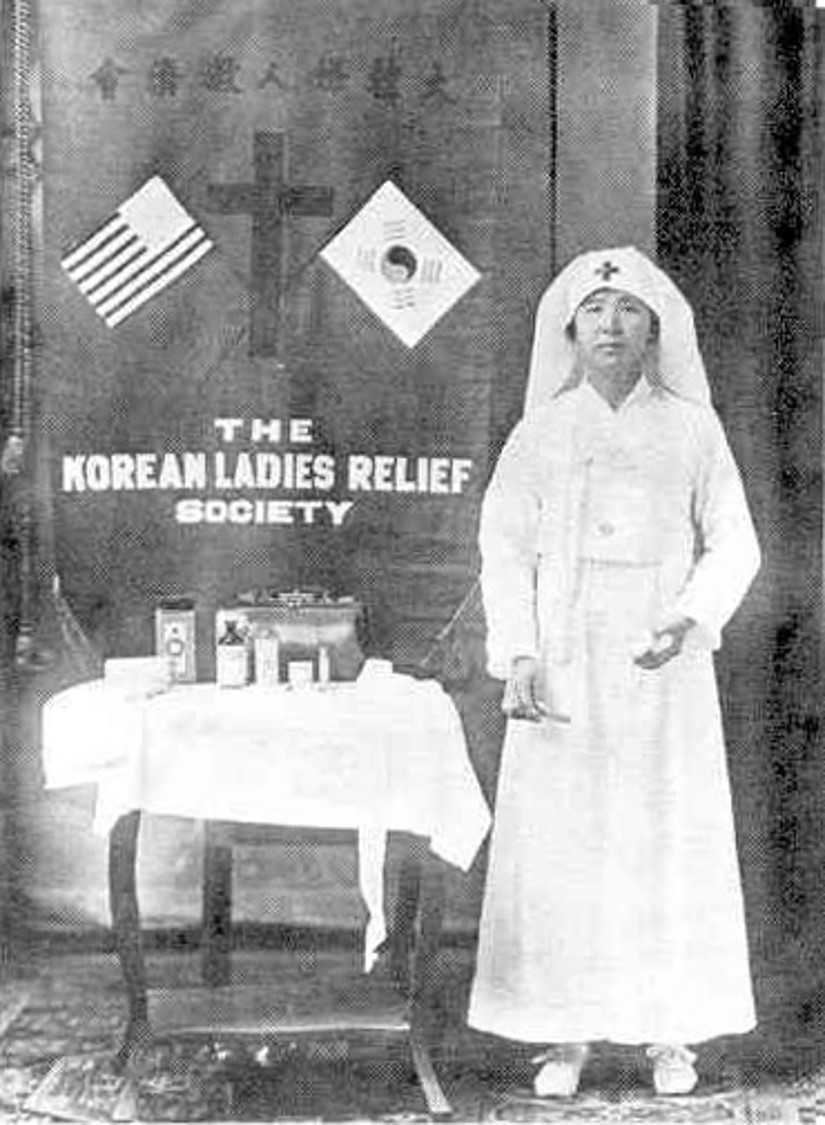
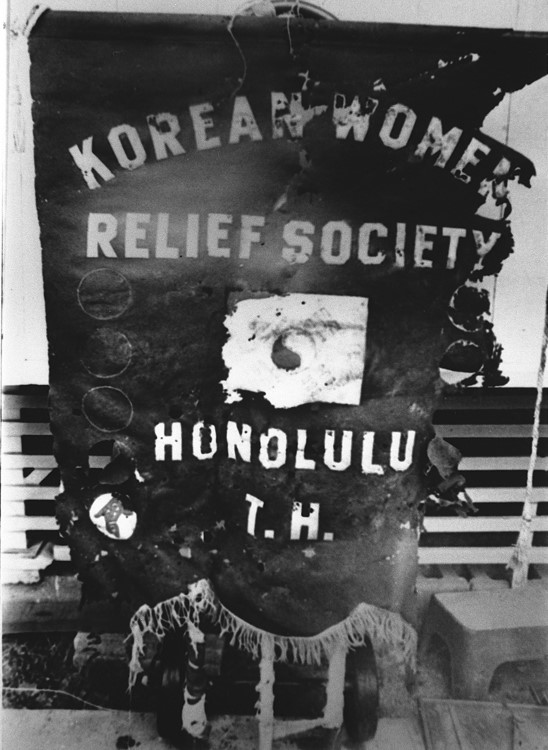

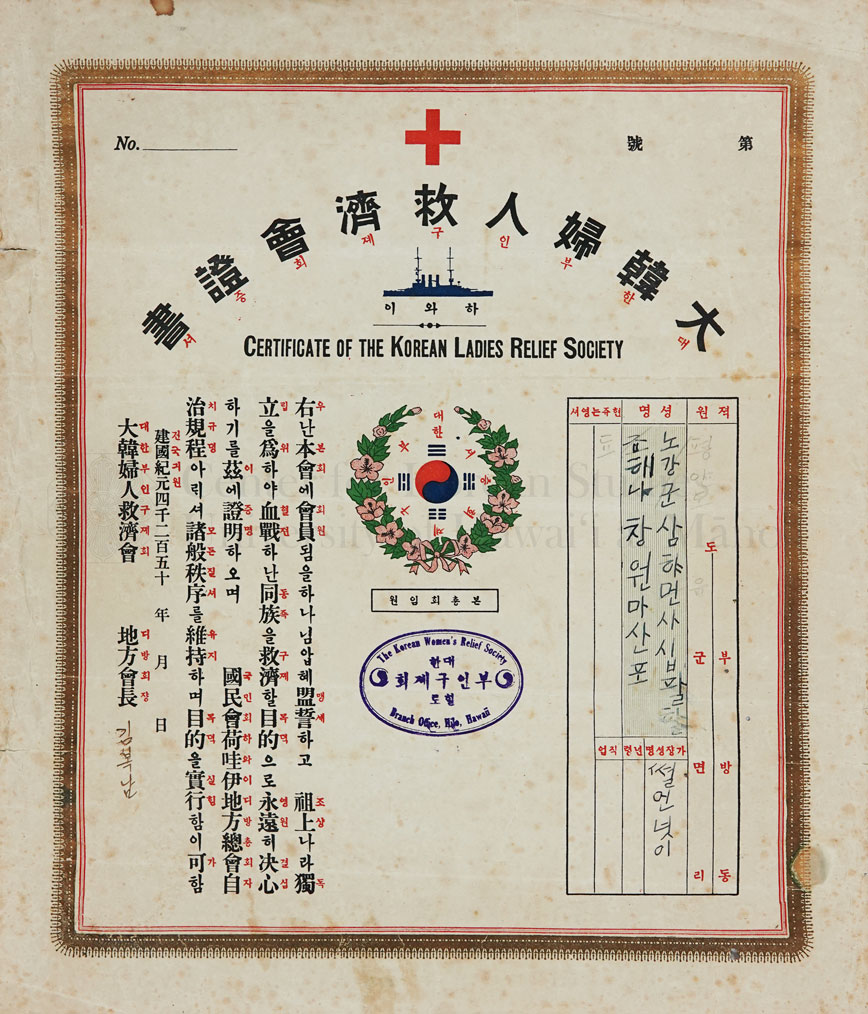
KWRS had its Central Committee undertake administrative tasks in overseeing various branch organizations. The Central Committee was comprised of representatives from branch organizations. Branch representatives had to be at least 22 years of age and capable of reading and writing Korean and Chinese or Korean and English. Branches were established throughout the islands and the Central Committee was located in Honolulu.
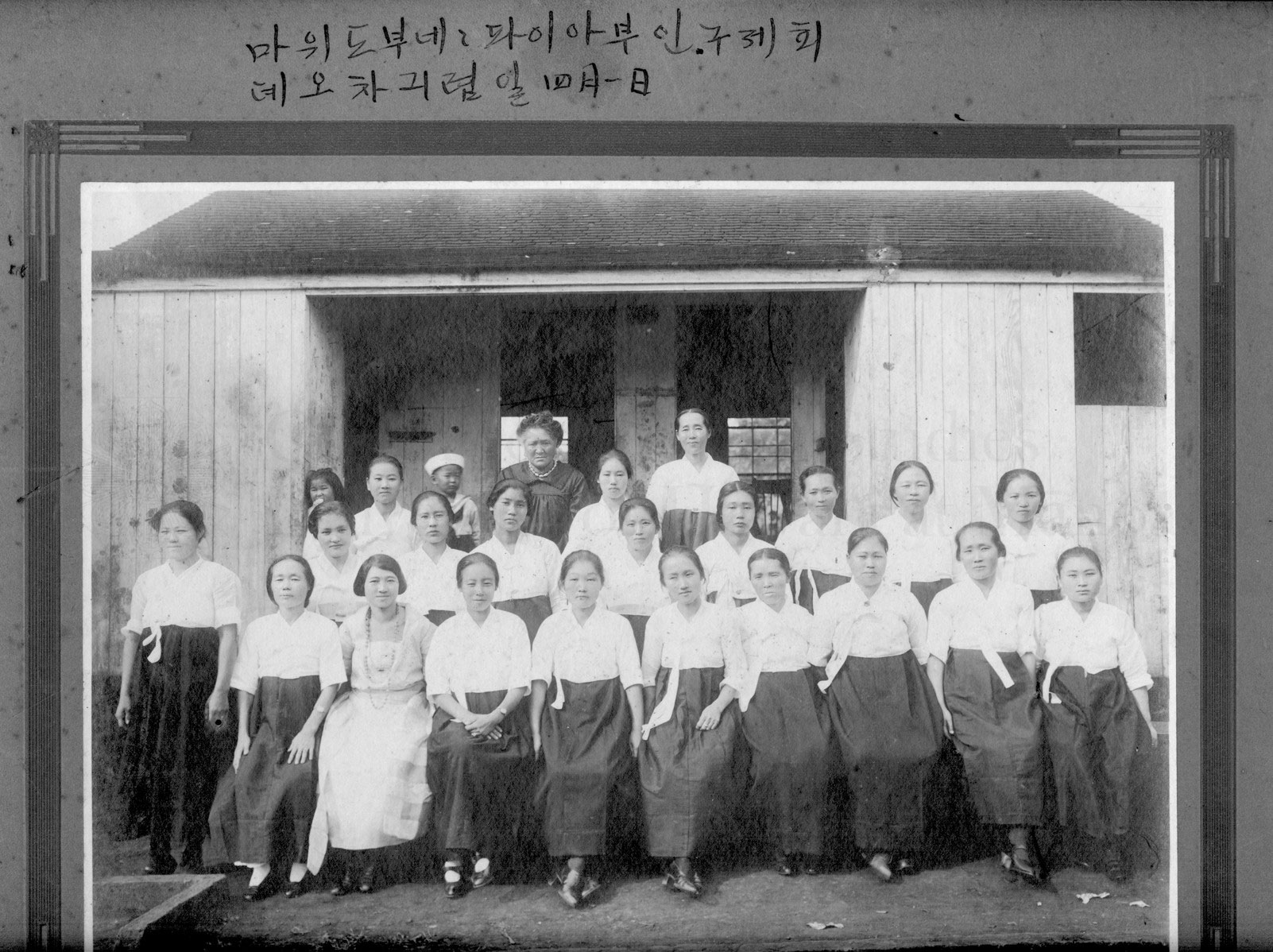
With $400 collected at their initial meeting on March 15, KWRS launched its first fundraising activity sometime in May or June 1919. They designed and printed 300 copies of 24-inch x 31-inch color posters of the Declaration of Independence. From the sale of posters that were printed by the Advertiser Publishing Company in Honolulu, KWRS made a net profit of $2,000. Out of the total $2,400, KWRS sent $800 to the Korean Provisional Government in Shanghai and $1,500 to Korea to help those wounded during the March First Movement. Continued fundraising efforts by KWRS made it possible to send $500 to support the Korean Independence Army in Manchuria in 1921.
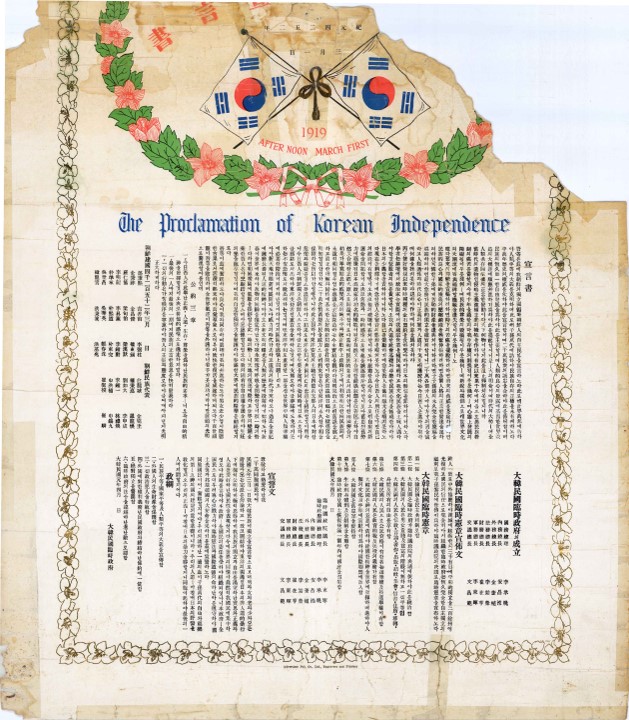
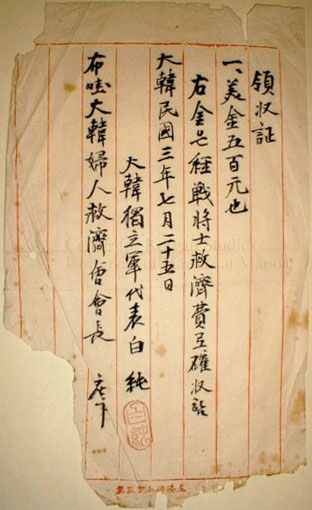
(Ministry of Patriots and Veterans Affairs)
In addition to raising funds to fulfill its organizational objectives, KWRS also promoted Korean culture by presenting music and dance programs, and even staging a traditional wedding ceremony. Members created dramas of traditional Korean tales such as “Hyonyeo Simcheong” (Filial Piety Simchdong) and “Pal Seonnyeo” (Eight Angels). KWRS staged dramas in Honolulu as well as in rural areas, with all roles played by members. Between acts, singing and dancing were introduced. By means of these cultural activities, KWRS was able to make a profit from ticket sales.
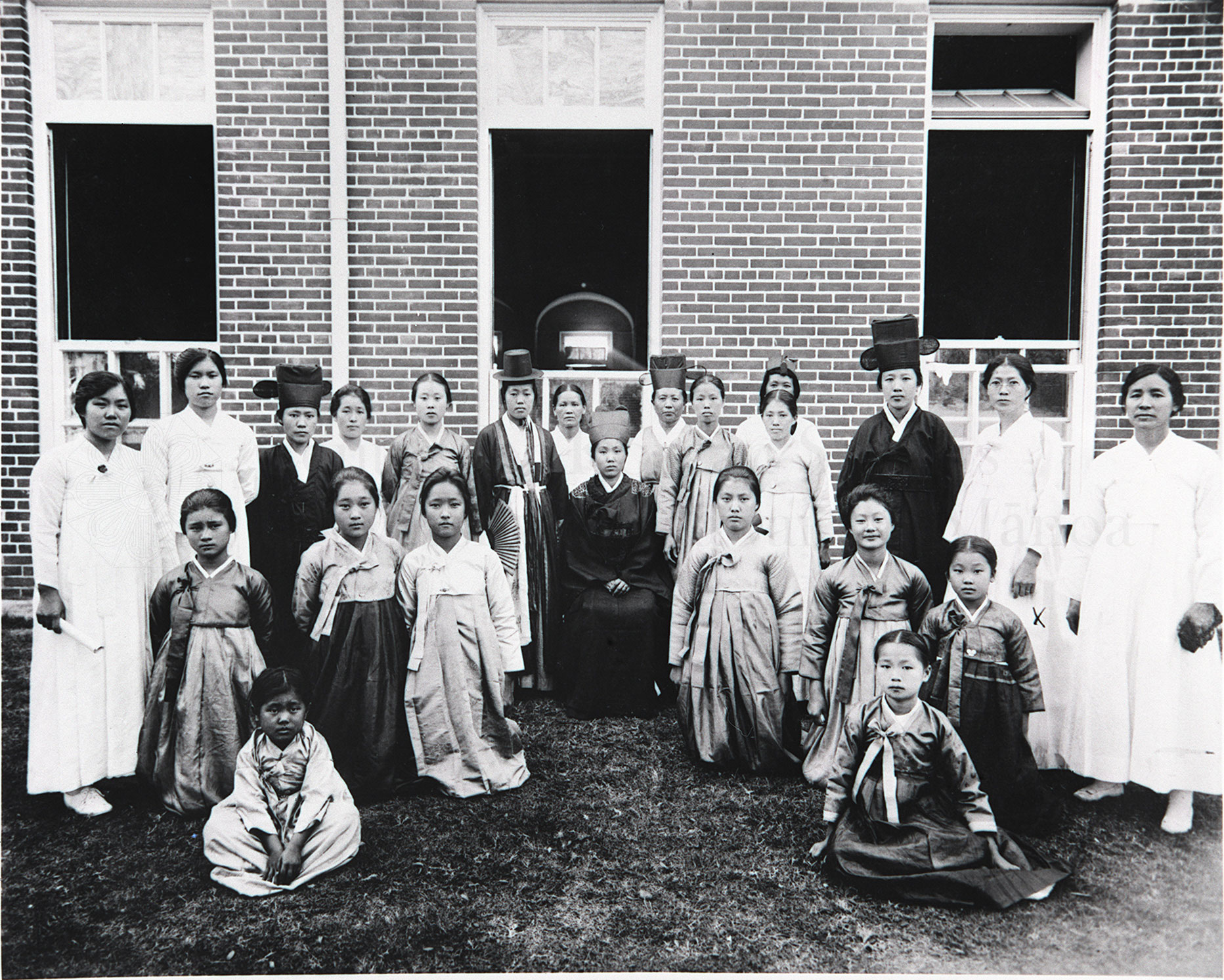
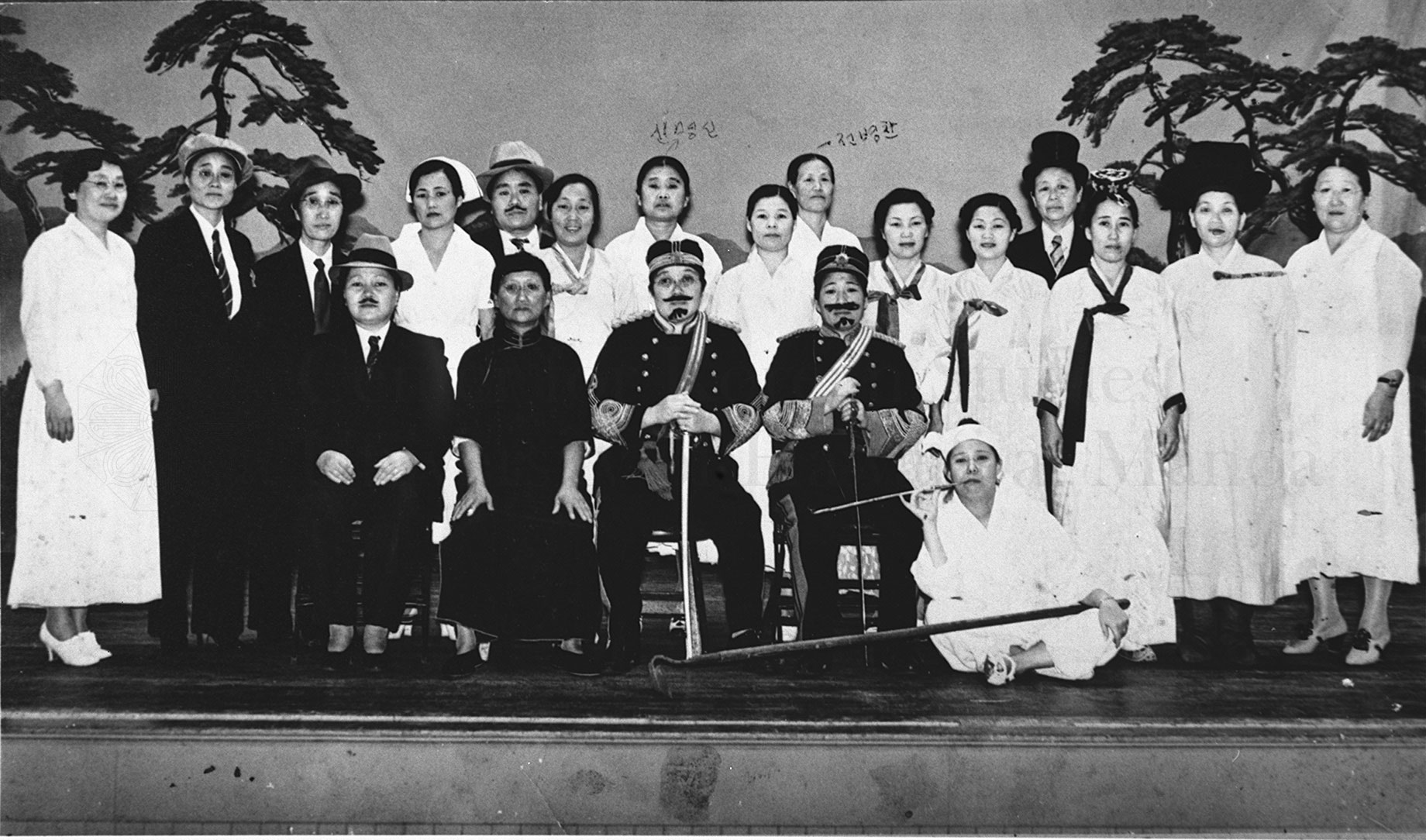
The total funds raised by KWRS by the end of WW II were estimated to be $200,000. This is equivalent to $4 million in today’s purchasing value. In the Beginning, the funds were used to support families whose members suffered during the March First Independence Movement. As time passed, KWRS' funds were used to support the Korean Provisional Government in China, the Korean Independence Army in Manchuria and Chungking, China, Korean-language newspapers in Honolulu, and Syngman Rhee’s diplomatic endeavors in Washington, D.C.
The KWRS's activities to help the mother country continued even after the end of WW II. KWRS collected various relief goods and sent them to Korea.
In 1947, KWRS continued relief activities in Korea by committing a pledge of $7,000 to Lim Young-shin 임영신 to establish an office in Seoul. The $7,000 was collected from the Honolulu branch ($5,400), the Wahiawa branch ($1,500) and the Hilo branch ($100).

President 손노듸
Vice Pres. 전영복
Secretary 이유실
Treasurer 윤순이
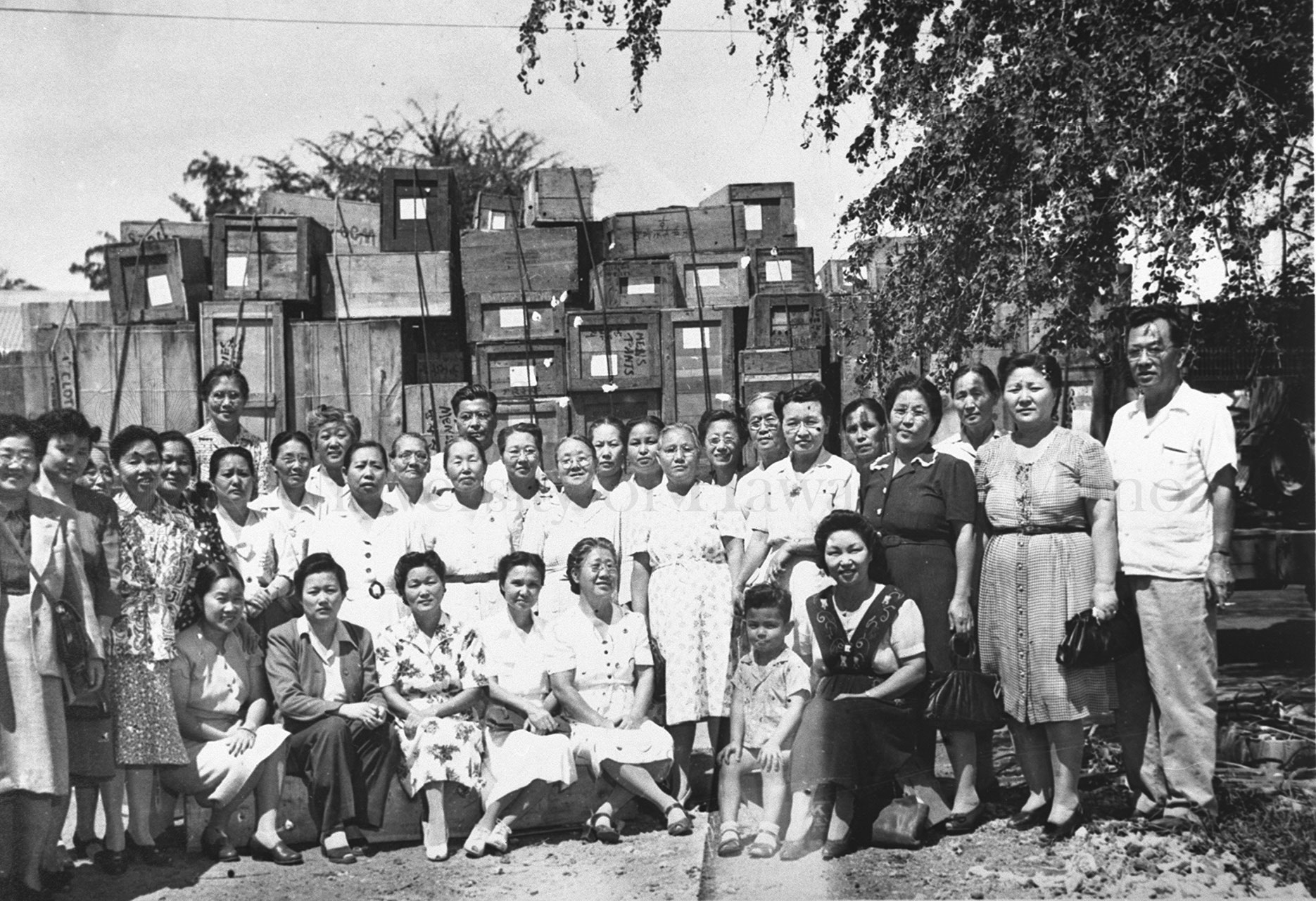
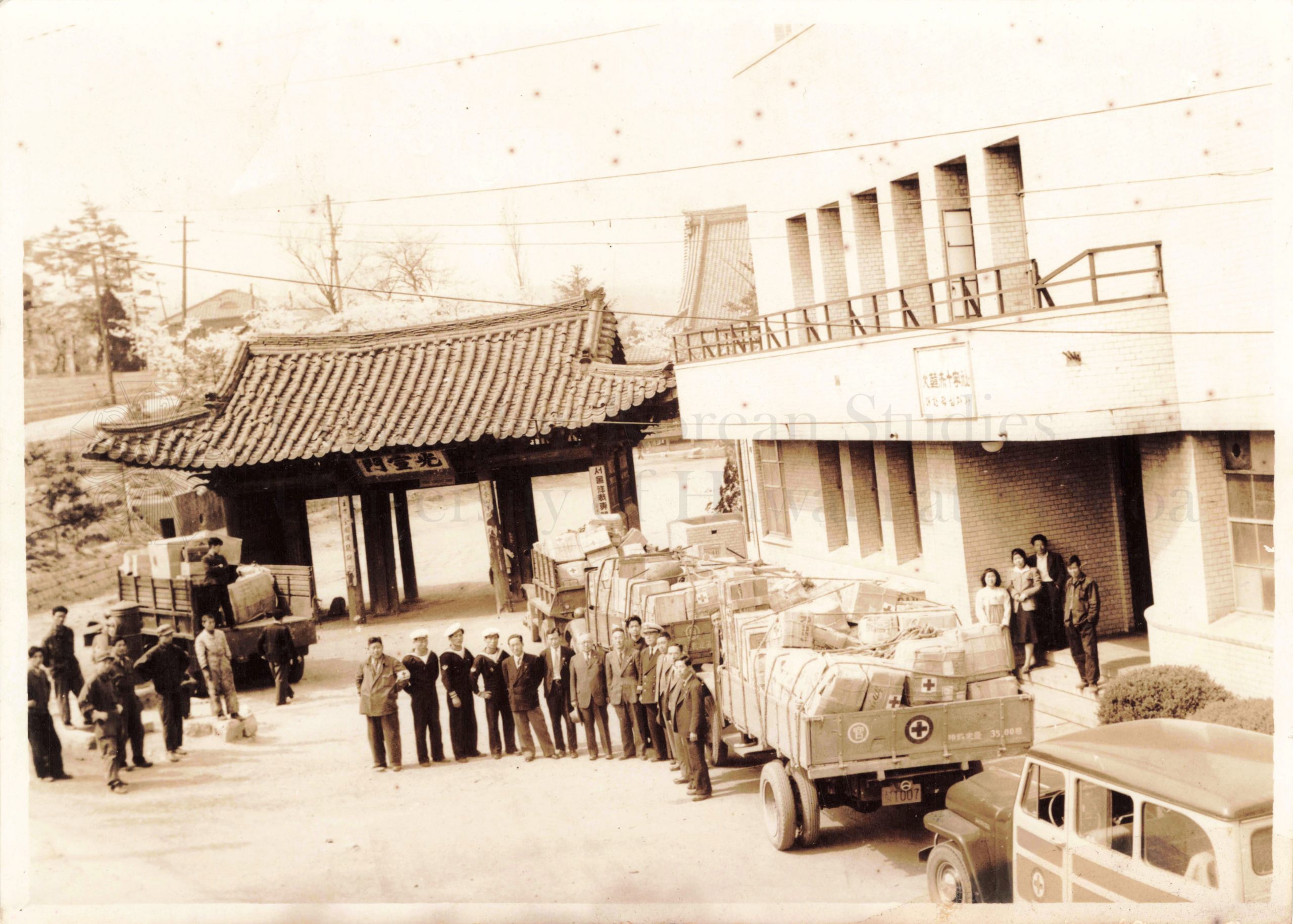
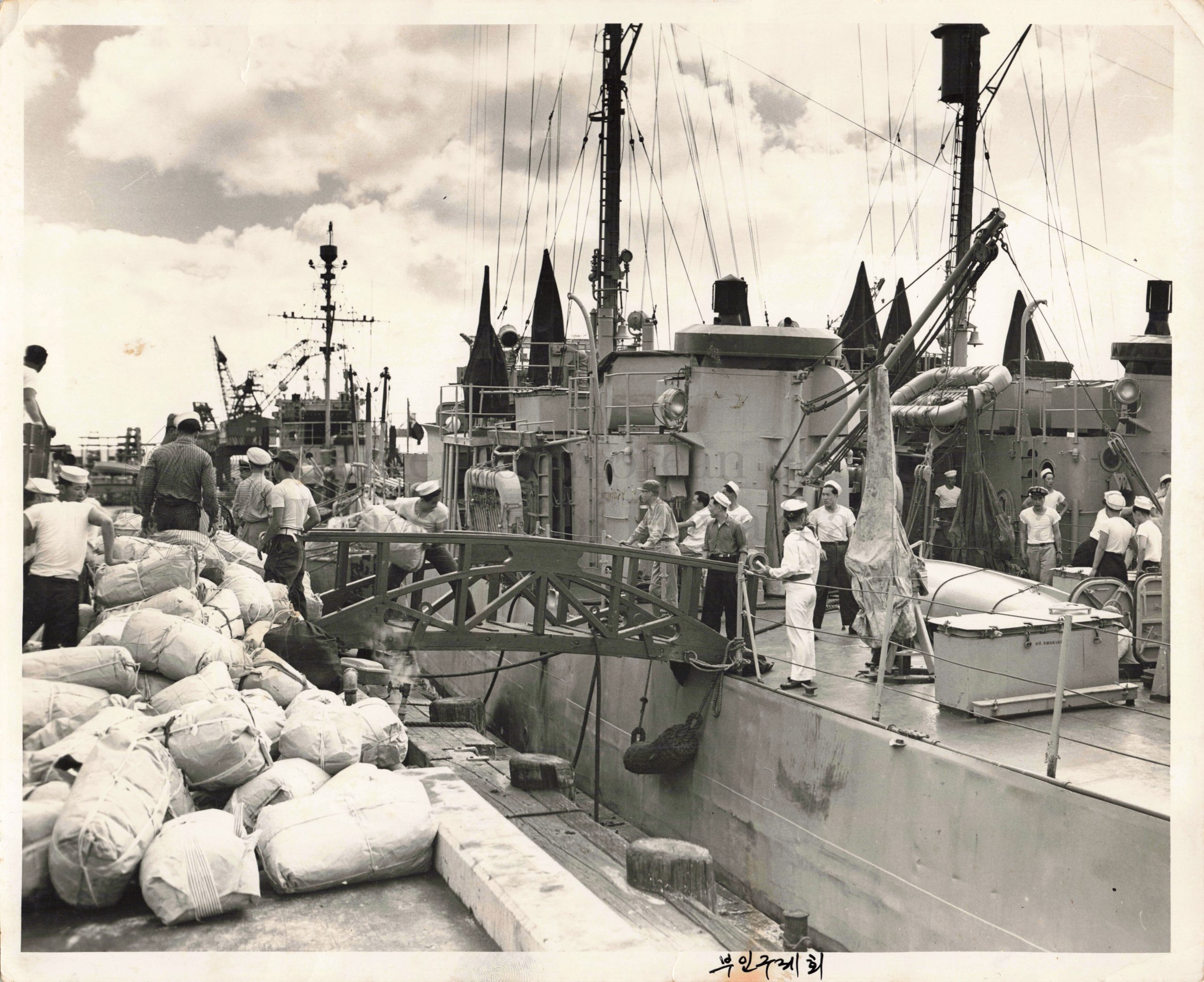
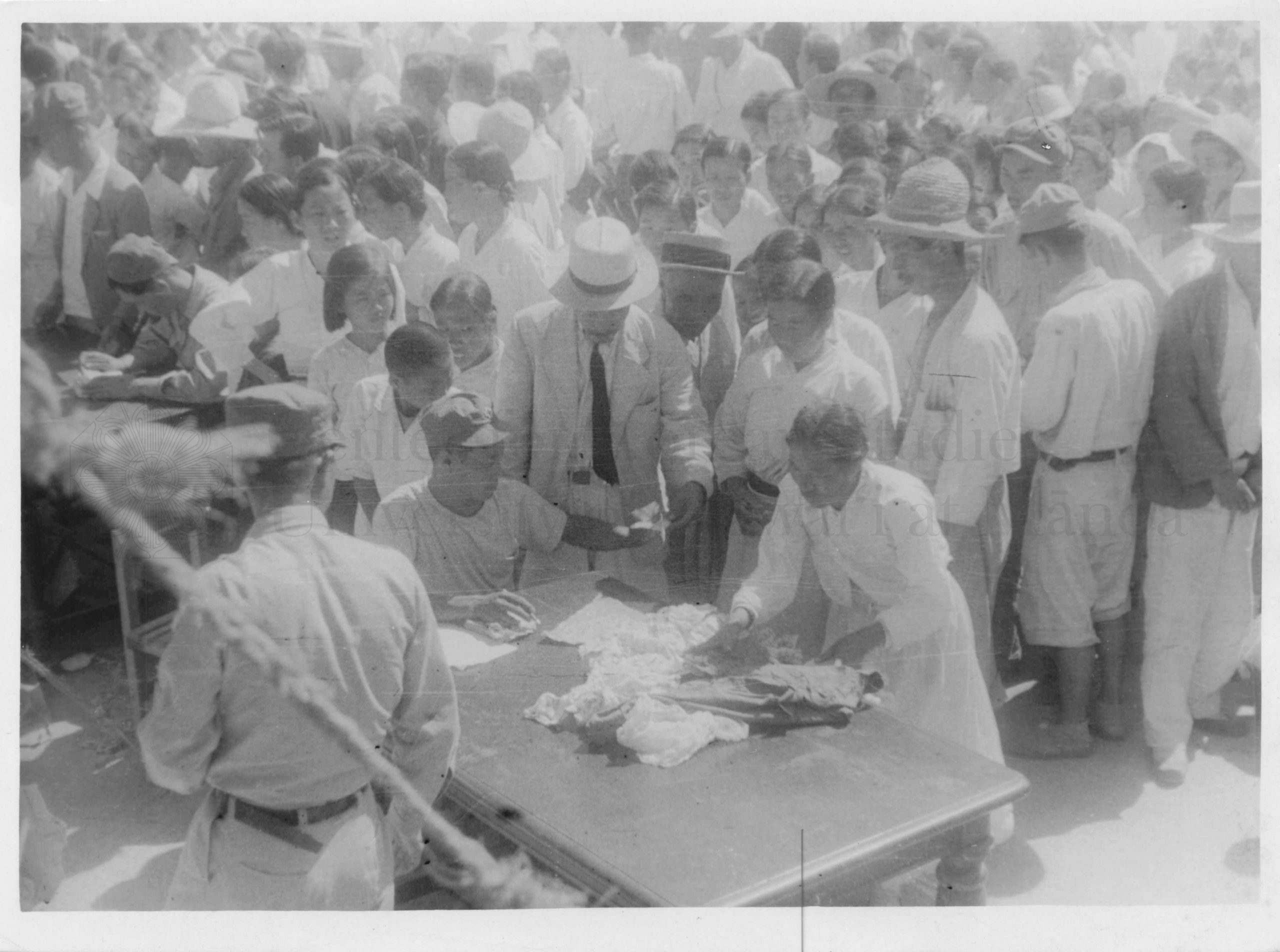
Amidst the busy fund-raising activities, KWRS also participated in various Honolulu community programs as the representative of the Korean community. On November 11, 1921, KWRS members paraded in white Korean hanbok and white headgear in the American Day celebration (Veterans’ Day). On Washington’s 200th birthday celebration on February 22, 1932, KWRS also participated in the parade. Although there were other Korean community organizations such as the Korean National Association and Dongji Hoi, it was KWRS members who represented the Korean community in such Territory-wide programs.
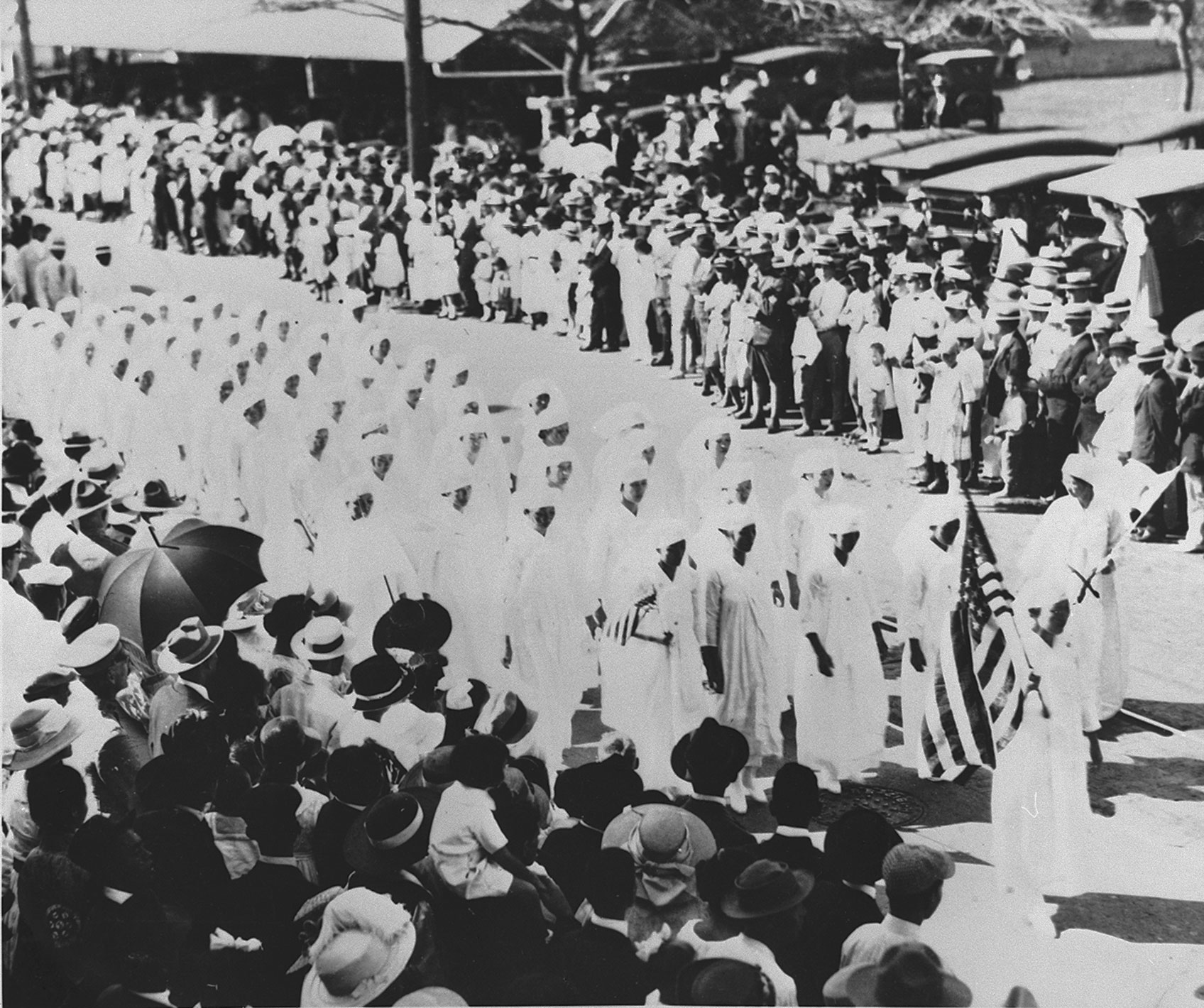
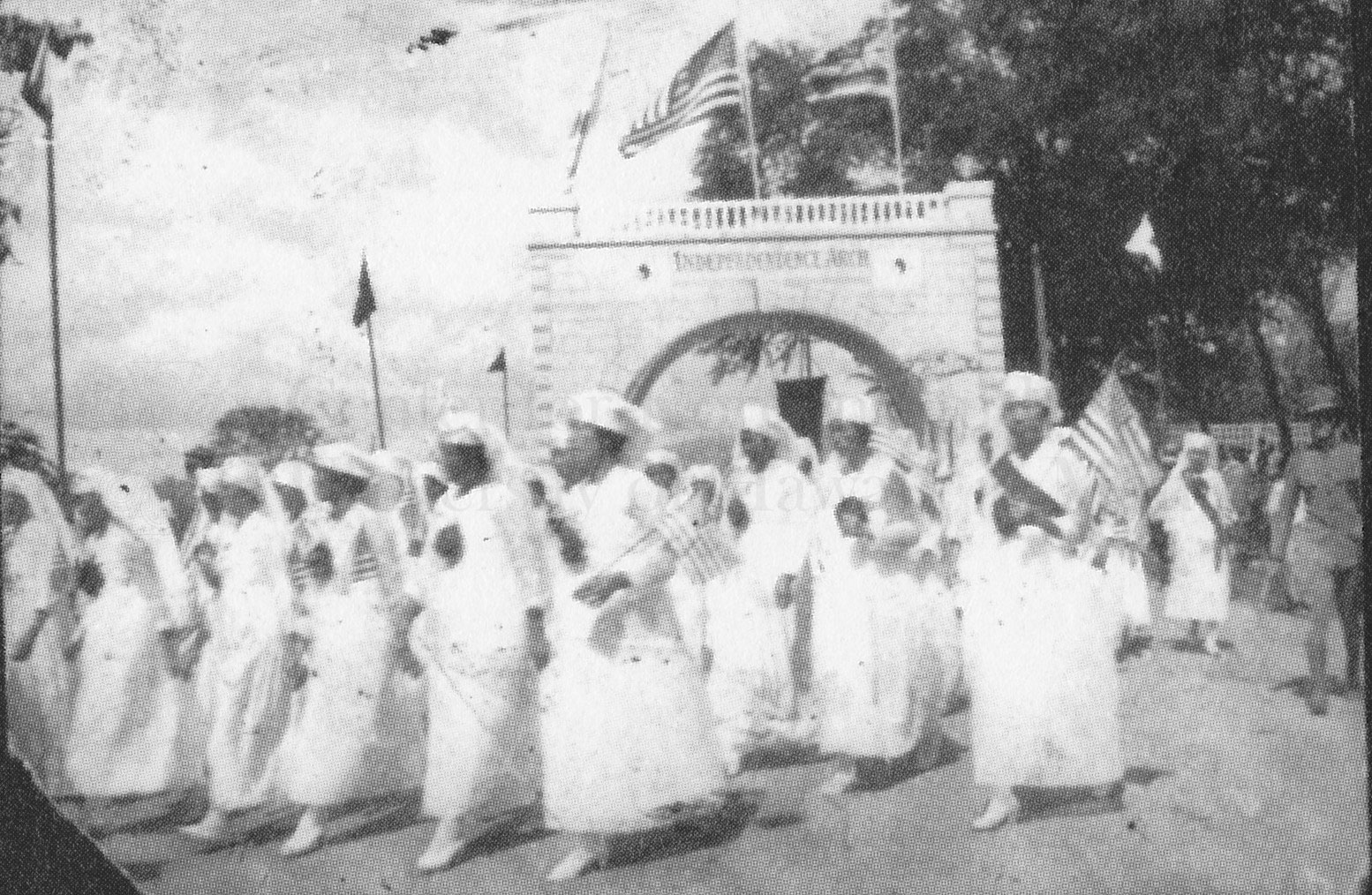
In December 1930, for a variety of reasons, KWRS was divided into two factions, and both insisted on using the same name. One may discern the responsible group by noting which newspaper reported on them: Korean Pacific Weekly 태평양주보 for the Dongji Hoi side and Korean National Herald 국민보 for the Korean National Association side. Stubbornly insisting on the same name, the two groups continued their fundraising activities to support the restoration of Korea’s sovereignty and to support the two newspapers. Although the two groups were united temporarily in 1937 and 1938, the union could not be maintained. Finally, on January 28, 1949, the KNA group changed its name to Korean National Women’s Society 대한국민부인회. The Dongji Hoi side kept the name KWRS until the 1970s.
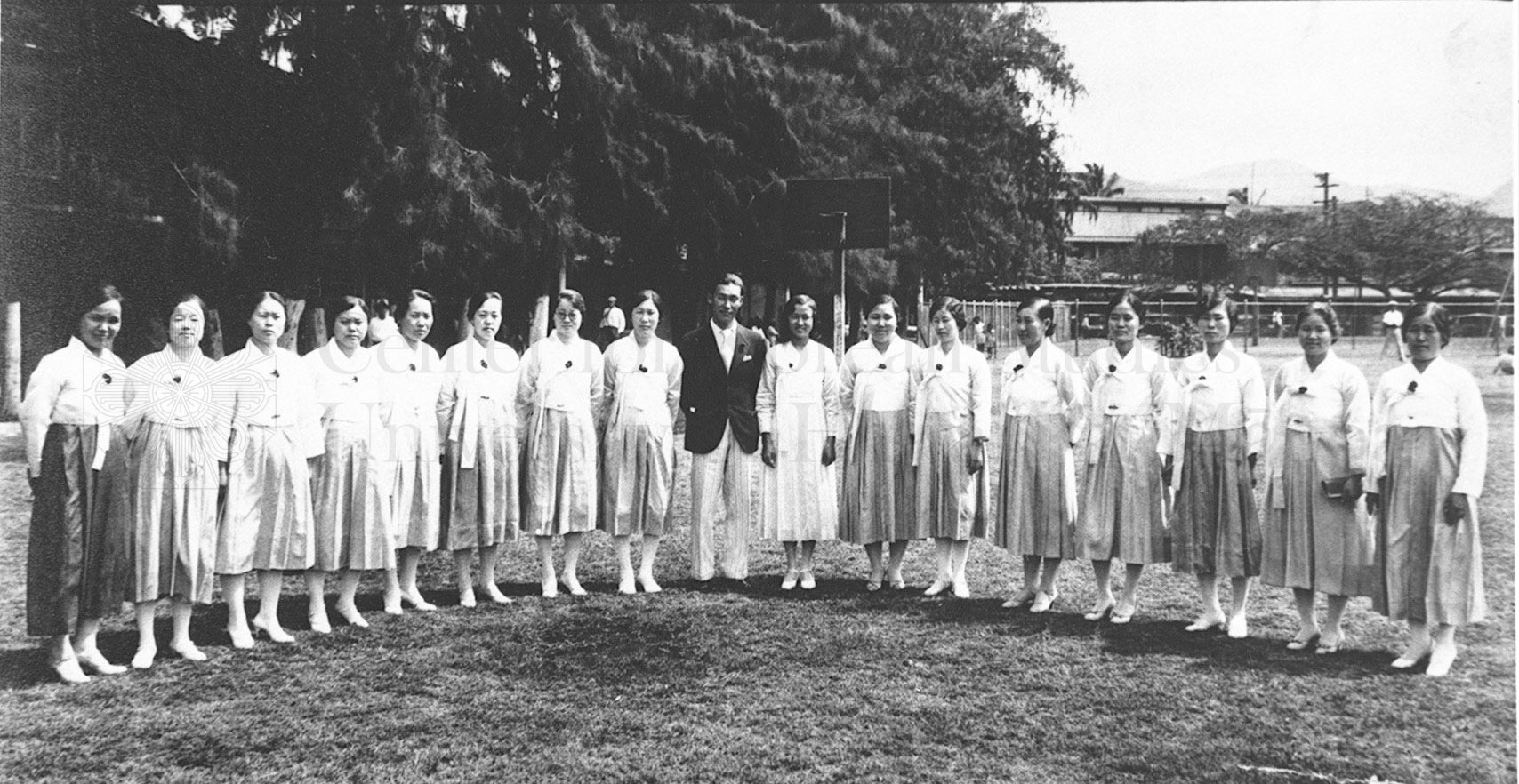
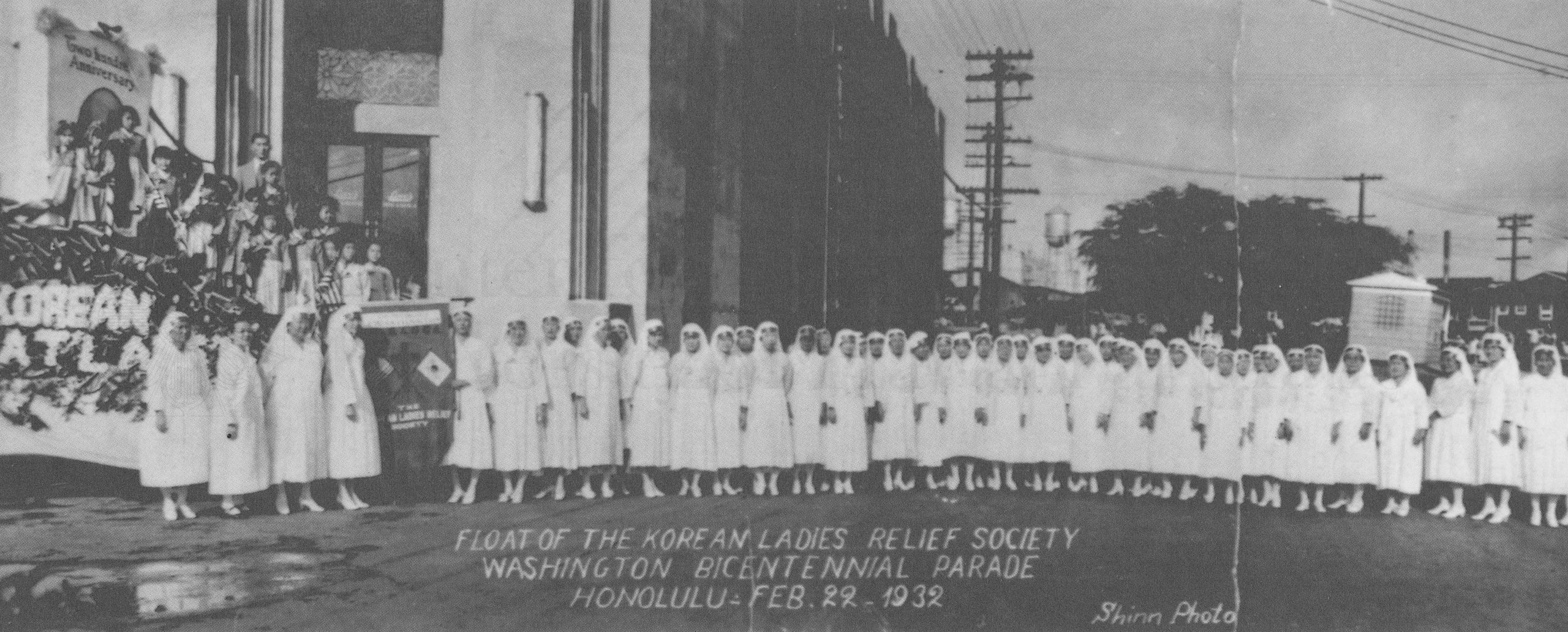
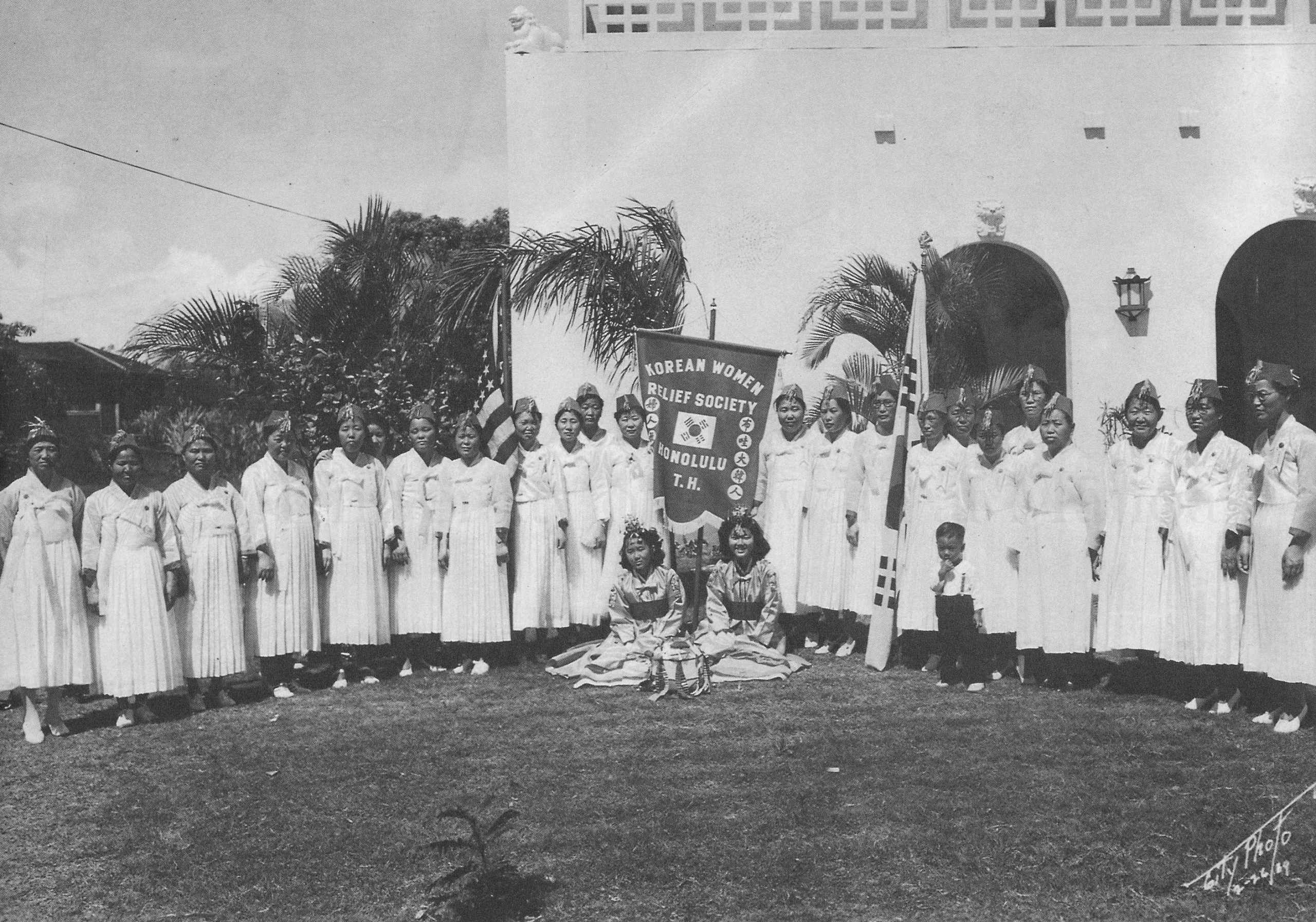
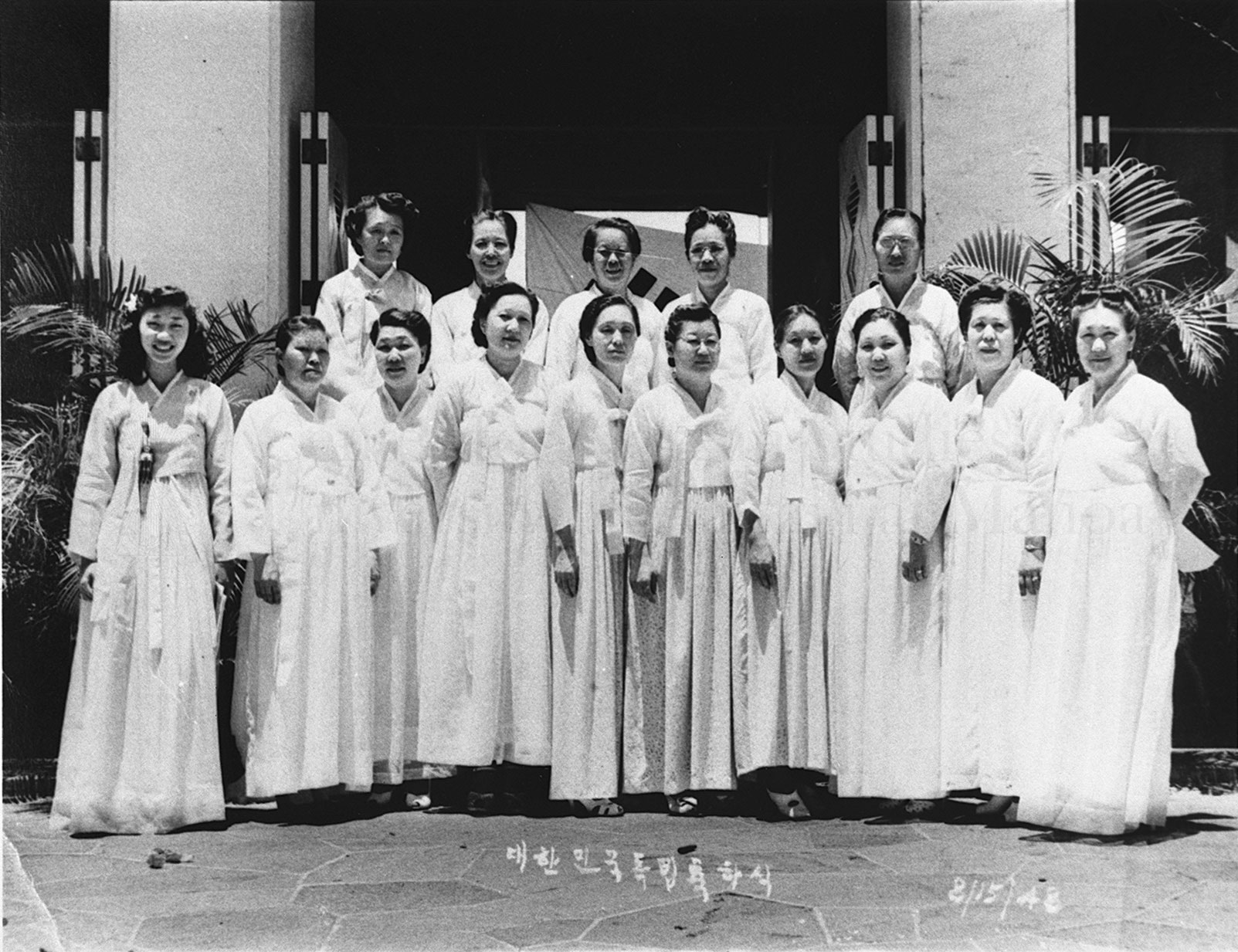
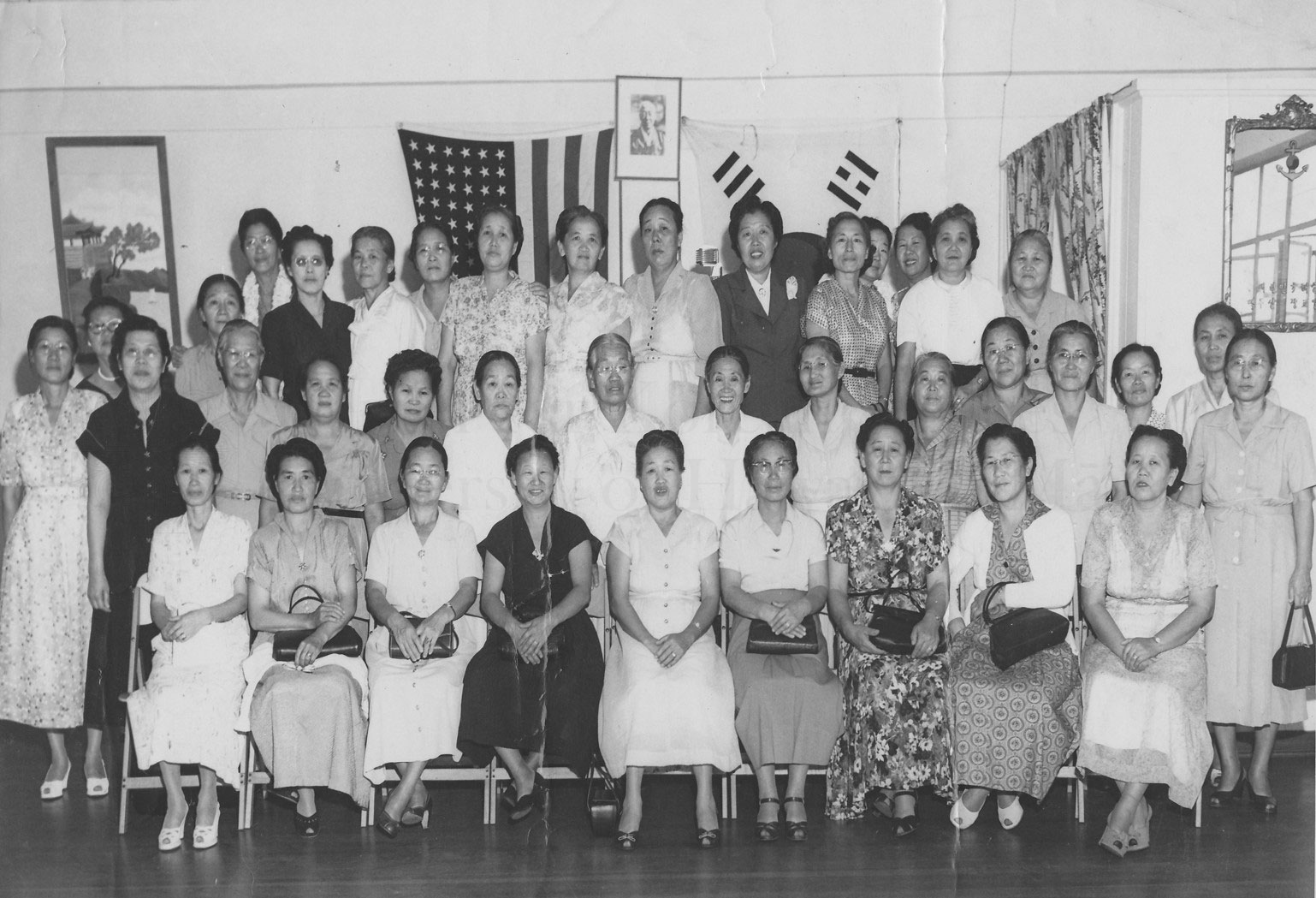
KWRS members were also leaders in the policy-making process when the United Korean Committee was organized in October 1940. UKC was formed for the purpose of supporting the United States military actions as well as helping small nations such as Korea occupied by foreign countries, to regain their sovereignty. Four members of KWRS were selected as delegates to UKC.
When the Korean Overseas Convention was held in May 1941, KWRS hosted a banquet for participating representatives. KWRS was the true “host” of the Korean community.
In October 1945, Chong Song Ahn and Geum Woo Park of KWRS were selected as delegates to visit Korea.
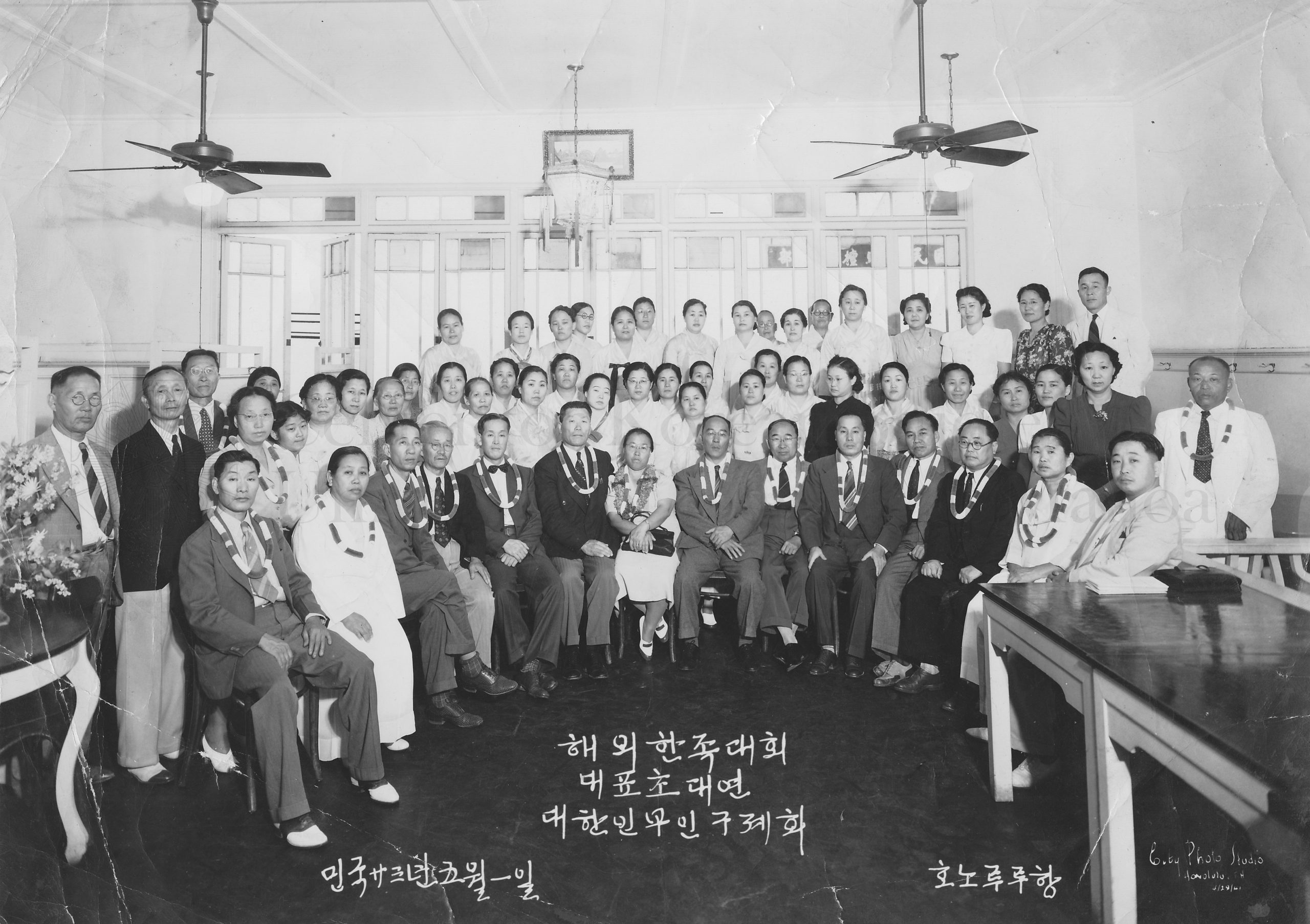
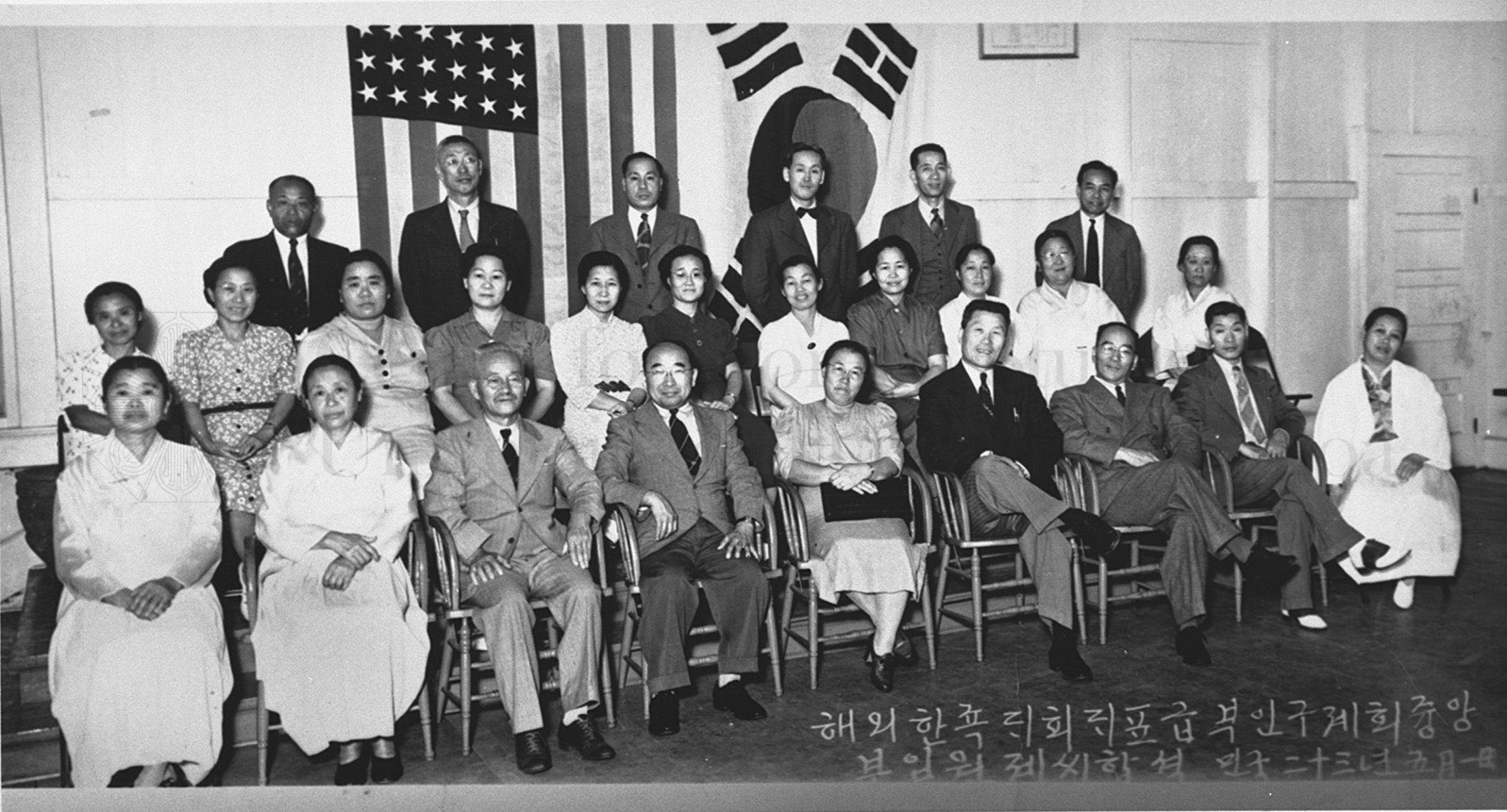
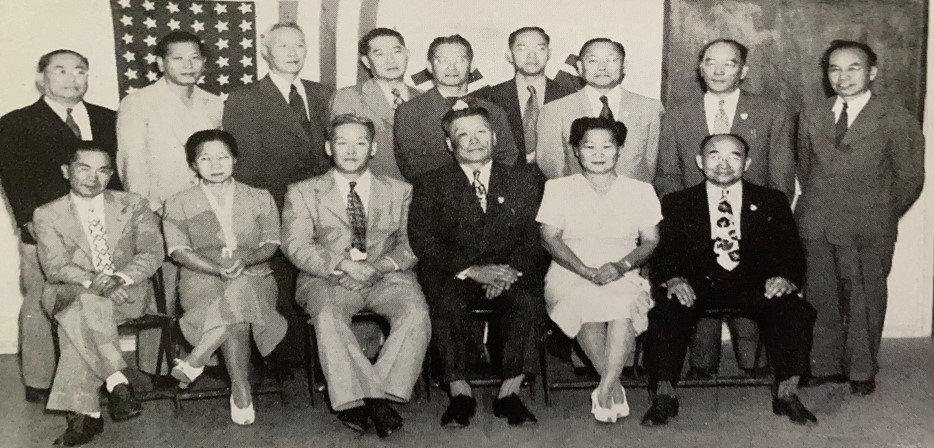
First row, second from the left: Chung Song Ahn / First row, second from the right: Geum Woo Park
The CKS Library holds various records of the KWRS Dongji Hoi, including minutes, financial records, and materials related to commemorative ceremonies.
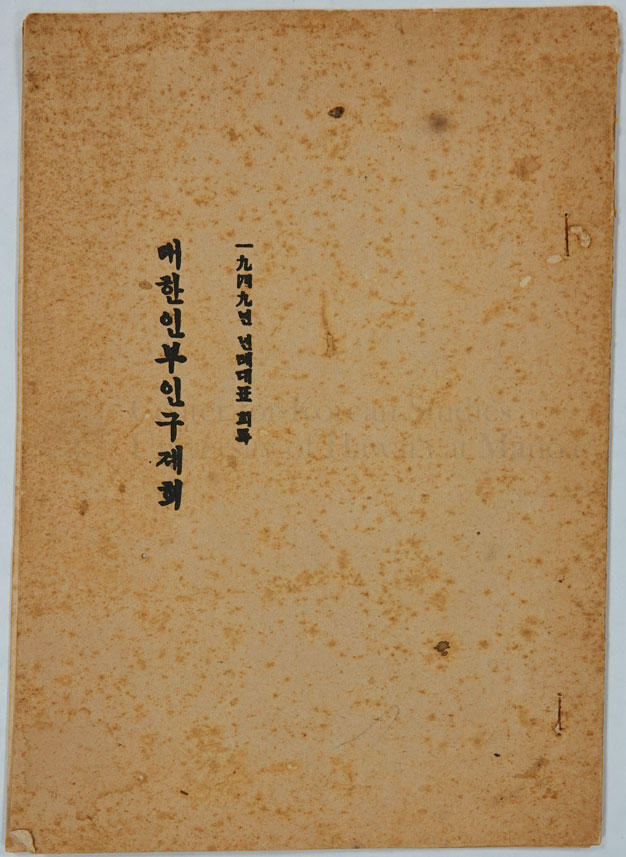
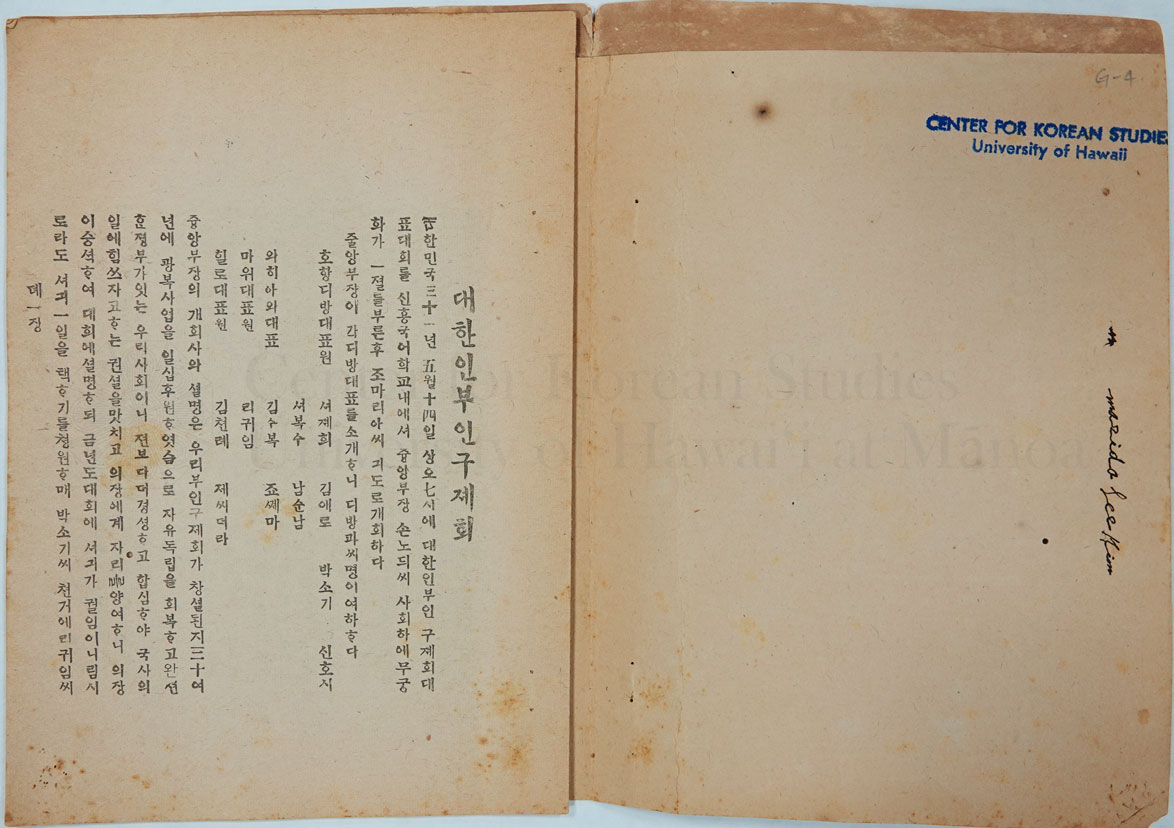






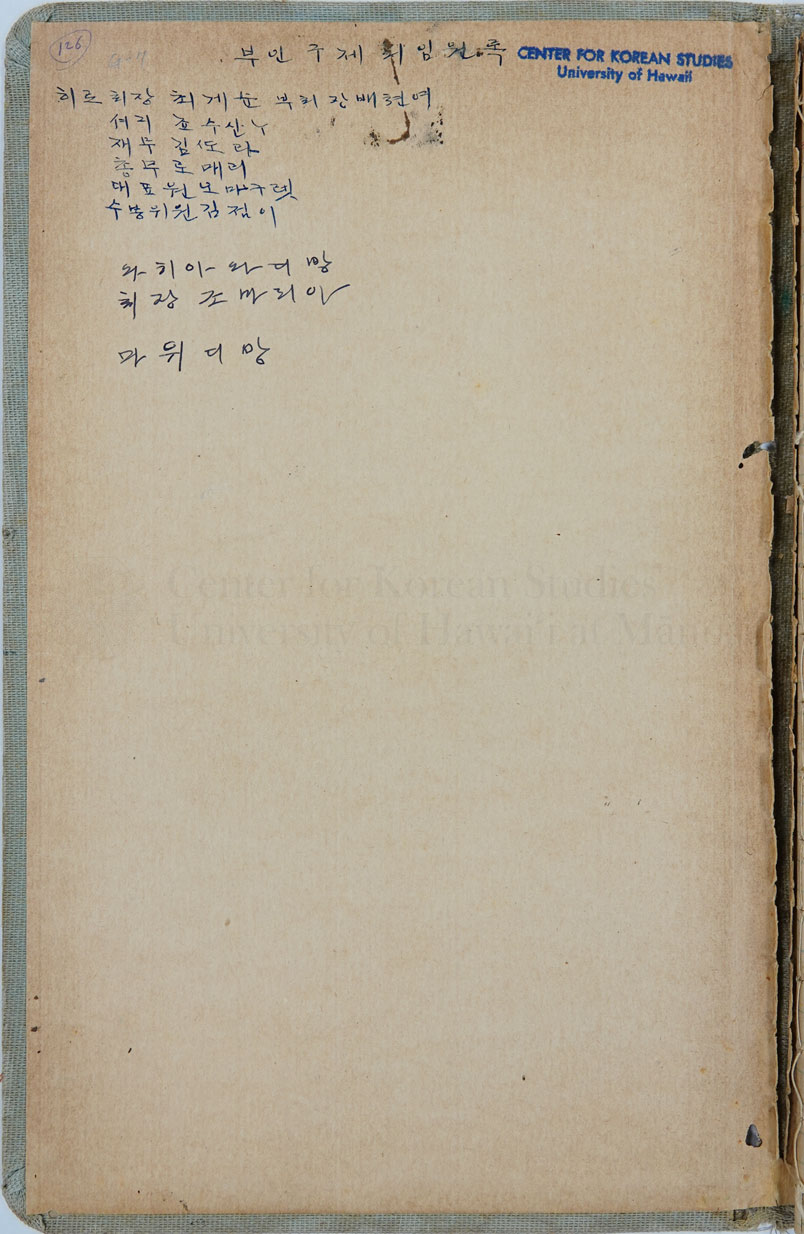
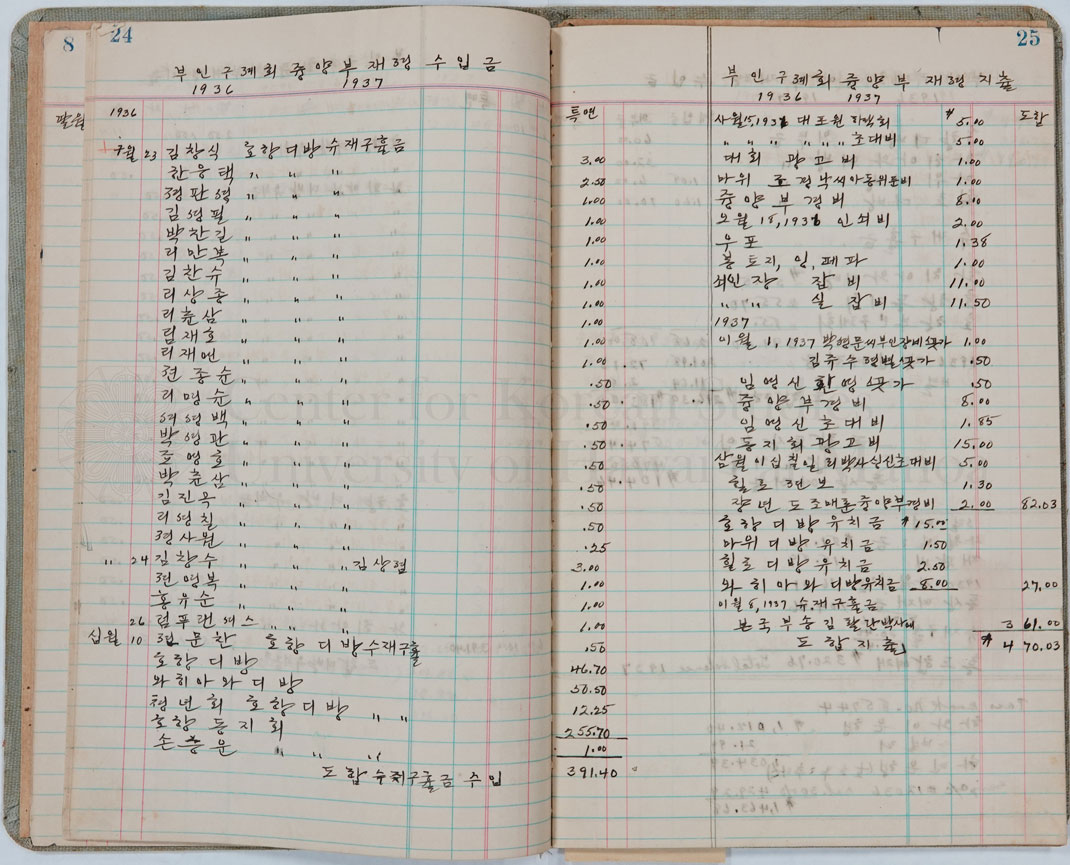
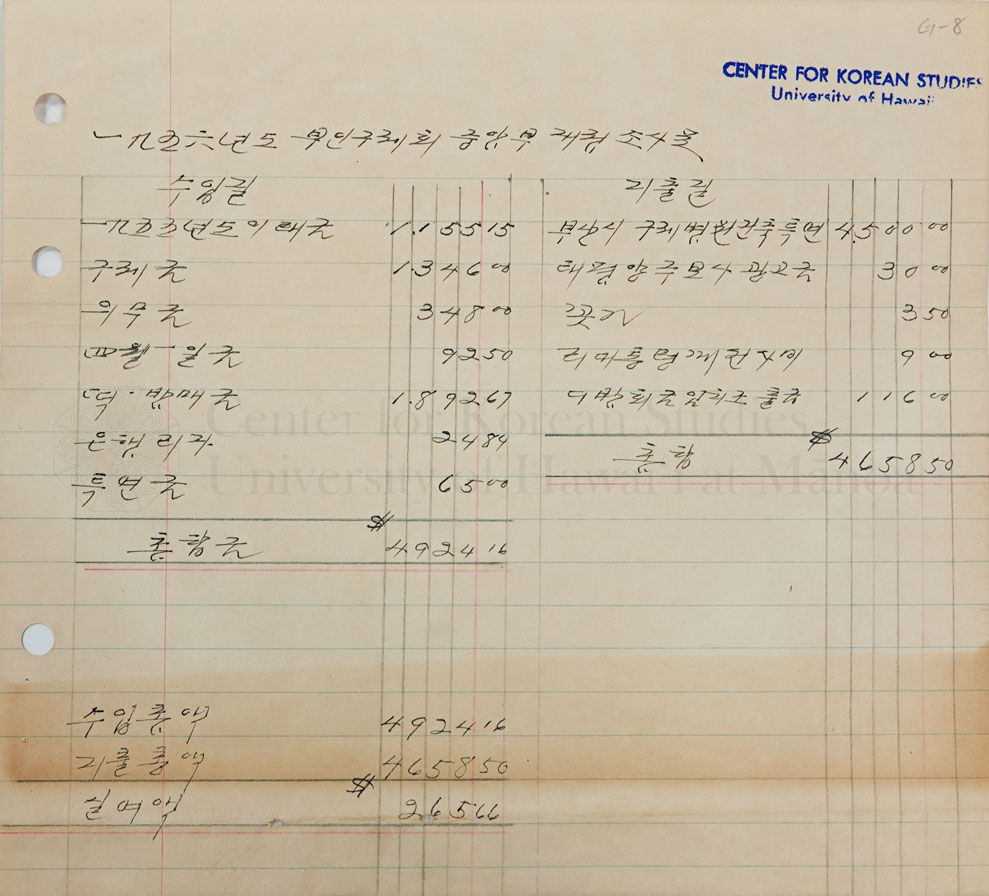
KWRS received the Presidential Commendation from the Republic of Korea for their patriotic supports on January 13, 1973.


The exhibition was prepared by Do Young Park & Duk Hee Lee Murabayashi.
Reference
- Committee on the 90th Anniversary Celebration of Korean Immigration to Hawaii. (1994). Their footsteps: A pictorial History of Koreans in Hawaii since 1903. Seoul: Ye Sun Co., LTD.
- Duk Hee Lee Murabayashi Collection, Center for Korean Studies Library, University of Hawaii at Manoa.
- Donald C.W. Kim Collection, Center for Korean Studies Library, University of Hawaii at Manoa.
- Korean Women's Relief Society Records, Center for Korean Studies Library, University of Hawaii at Manoa.
- Ministry of Patriots and Veterans Affairs. https://e-gonghun.mpva.go.kr.
- The Independence Hall of Korea. https://search.i815.or.kr/.
Donation
If you would like to make a donation, please click here. For specific use of the donation, please note it in the "Additional Donor Information/Special Instructions" section.
